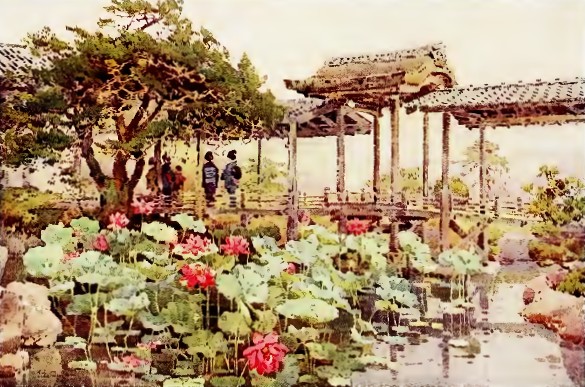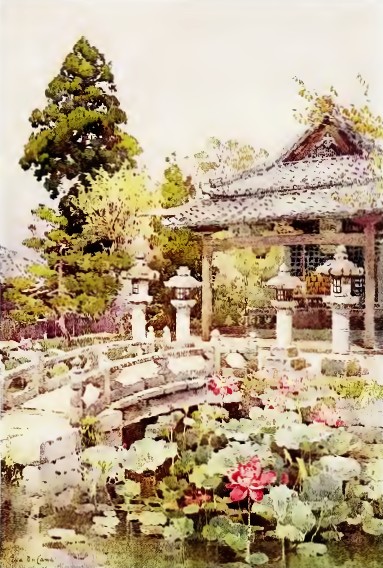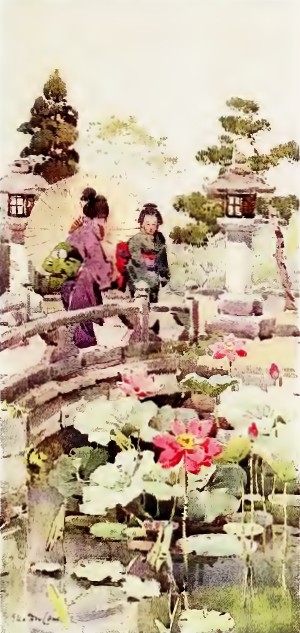| Web
and Book design,
Copyright, Kellscraft Studio 1999-2013 (Return to Web Text-ures) |
 (HOME)
|
| CHAPTER
XIV THE LOTUS THE
"time of the lotus" is suggestive of the damp hot August
days when from earliest dawn the cicadas will be singing, if their
discordant noise can be described as song, and the croaking of the
frogs day and night, makes one wonder at last whether frogs never grow
hoarse, or cicadas never tire of
singing. From the last weeks in July till the first weeks of
September the lotus will be blooming bravely, undaunted by the
sun's fierce rays; and the first breath of autumn, which brings new
life and energy to a human being after the heat of the summer, will
mean death to the lotus. Truly it is a beautiful flower this flower
of Buddha, as from its close association with the Buddhist religion
it seems essentially to belong to Buddha. The colossal figures known
as the Dai butsu at Kamakura and Nara sit
in immovable calm as though
drawing inspiration from the bronze lotus before them; the silence of
their souls is the silence of the flowers, and the shape of the open
blooms in the sunlight is the symbol of Buddha's enlightenment
Every little idol of Buddha, be it in the family shrine or grand and
stately temple, sits upon a lotus throne; the temples are all
decorated with carved lotus or the freshly cut flowers in their
season; gold and silver paper lotus are carried at funerals;
tombstones are often set upon a stone base in the form of a lotus
flower, and lotus beds are planted near shrines. The mighty feudal
lord Iyeyasu sleeps in the silence of Nikko's cryptomerias,
hearing only once in a while
the long sad cry of a great bell, and before him as his only
companions are the eternally same bronze lotus flowers. So not only
is the lotus the especial flower of Buddha, but it is also regarded
as the flower of death, and for that reason it is disliked as a
decoration for any occasion of rejoicing.  Lotus at Kodaiji
There is no more beautiful sight than a lotus bed at the dawn of a hot August day. Stately and yet tender is the beauty of the lotus blossom, the great buds opening with a noise which is indescribable to one who has not heard it; and how quickly the delicate pink or white petals unfurl, as though hastening to make the most of their short life, for before the overpowering heat of the August noonday the flower closes, to open once more on the morrow and then die a graceful death; the petals dropping one by one, but still retaining all the freshness of their colour, and then nothing will be left but the great seed pod, very beautiful in itself, but not as beautiful as the great bluish-green leaves studded with dewdrops, which seem to reflect every passing cloud. For the beauty of the lotus lies not only in its flowers; you will begin to see the beauty of the plant even when the tender young leaves peep out shyly upon the surface of a pond in early June; their colour is dark brown, and the Japanese call them zeniba from their resemblance to the shape of copper money. Then day by day the leaves will spread and float out as a spirit upon the water, gradually the stalks grow and they will get higher and higher, their broad curling surfaces losing the bronze colour and turning to every shade of soft green and deep emerald; and so through all the scorching summer days they remain fresh and cool to look upon, until in October they begin to flag, but they will be beautiful even in death. The stalks then seem too weak to carry their burden any longer, and suddenly, even as one watches them, the stem bends near the top, and the great curling leaf will give one last shiver in the breeze, topple, and turn over and hang with head bent as if in penitence. Though the beauty of each individual flower may be short-lived, each morning will bring fresh buds, which in a few hours open into fresh flowers, bringing new beauty to the lotus bed; so its glory lasts for six long weeks.  Lotus at Kyomidzu
For the true lover of the lotus there can be scarcely any night, for soon after midnight he must rise and start for the lotus pond to see their real beauty and hear the opening of the buds with the sudden touch of dawn; so in old days the Japanese used to visit the famous Shinobazu pond in Uyeno Park, where the little temple dedicated to the goddess Benten stands on a small peninsula, as though to protect the lake from desecration, though if that were her mission she has surely failed. Four years before, I too, in the early morning, had visited the Shinobazu pond, and filled with awe and admiration had spent many hours watching the rosy petals open, and the great glaucous leaves toss hither and thither with every breath of wind, and the iridescent dragon-flies darting through the air; until driven away at last by the overwhelming heat, I had to seek shelter from the sun. Again last August I felt I must see the lotus at Uyeno in all their glory; but I feel ashamed, for the traditions of Japan, to say what greeted me. Great staring Exhibition buildings in the worst possible taste have been built all along the shores of this historical lake. But the worst part is still to come: overshadowing the little shrine and into the very heart of one of the great stretches of lotus leaves dashed a water-chute. It took my breath away. I stood spell-bound, and then turned away with horror and asked myself, as many other people, alas! are asking: "Are the Japanese losing all their artistic feelings?" Happily there are still many quiet spots where lotus grow, away from the desecrating hand of the "new Japan," and there we can sit and enjoy this "emblem of purity," its clean fresh flowers and leaves rising unsullied from the stagnant mud; and this is one reason for associating it with a religious life, or comparing it to the virtuous soul of a woman who lives in suspicious surroundings. A favourite Buddhist precept says: "If thou be born in the poor man's hovel, but hast wisdom, then art thou like the lotus flower growing out of the mud!" Wherever undisturbed pools and channels of muddy water exist, the lotus is to be found: the old moats surrounding the remains of a grand old Daimyo's castle, the muddy temple or monastery ponds, and even the ditches beside the railway, will all be rendered gay in the summer, when the great pink and white lotus are in bloom. Their history is a very old one, for their beauty is sung in the old Buddhist sutra, and one passage describing the golden glory of Paradise tells of "a pond where the lotus flowers large as a carriage-wheel grow; the green flowers shine in green light, the yellow flowers in yellow light, red flowers in red light, and the white flowers are supreme in beauty and odour." It may be true that the leaves are as large and round as a carriage-wheel — of a Japanese carriage, a kuruma; and certainly I should be afraid to state rashly how large and high the foliage of the white variety may grow. The white Nelumbium speciosum, for all the so-called lotus of Japan are really this species of water-lily, has a powerful and sweet perfume; but the pink ones, which are far more beautiful, have but little scent. I think the leaves and their stems, as well as the flower, must have their own peculiar odour; for often I noticed near lotus beds, where no blossoms were to be seen, a strong and rather sickly perfume came floating in the air in whiffs which will always be associated in my mind with lotus, as I cannot compare their scent to that of any other flower. There are other varieties, one a deep crimson colour and one called "gold-thread lotus," but these are seldom seen. The Indian lotus has a larger double flower, deep pink in colour, which never closes day or night, and the blooms last in beauty for five or six days. In India, the source and centre of Buddhism, the lotus has been chosen as a national flower, and Burmah also is famed for its lotus; so wherever Buddhism makes its presence felt, there you will find the lotus. Sir Monier Williams says that "its constant use as an emblem seems to result from the wheel-like form of the flower — the petals taking the place of spokes, and thus typifying the doctrine of perpetual cycles of existence." The lotus is a favourite subject with the Japanese artist in conjunction with the mandarin duck and other water-fowl, and so faithfully do the Japanese represent their flowers that each vein in the leaves seems to be depicted if not exaggerated. Mr. Parsons admirably describes the lotus, and also this form of exaggeration and mannerism in their art. —
Take for example the spots on the lotus stems; if you look very closely you can see that there are spots, but certainly it could not strike every artist as a marked feature of the plant, for they are not visible three yards away. But some master noticed them many years ago and spotted his stems, and now they all spot them, the spots getting bigger and bigger; and so it will be until some original genius arises who will not be content with other people's eyes, but will dare to look for himself, and he may perhaps, without abandoning Japanese methods, get nearer to nature, and start a renaissance in Japanese art.
He also remarks —
The lotus is one of the most difficult plants which it has ever been my lot to try to paint: the flowers are at their best only in the early morning, and each blossom, after it has opened, closes again before noon of the first day; on the second day its petals drop. The leaves are so large and so full of modelling that it is impossible to generalise them as a mass, each one has to be carefully studied, and every breath of wind disturbs their delicate balance and completely alters their forms. Besides this, their glaucous surface, like that of a cabbage leaf, reflects every passing phase of the sky, and is constantly changing in colour as clouds pass over.
Such is an artist's true appreciation. No honour seems too great for this flower of Buddha, and we are told that you will be permitted, if you are fortunate enough to be among those who are admitted into Nirvana, or Paradise, to sit upon the lotus throne, leaving behind the dirt and dust of the world. In the days of old Japan, when the religious influence was stronger, and far more romantic than it is to-day, to sit together upon the lotus throne in Paradise was the customary dream of two lovers who wished to commit suicide. Another honour for the lotus is that the Japanese dedicate their wonderful and awe-inspiring mountain Fuji-san to it, and call it Fugo Ho, meaning Lotus Peak. Thousands of their poets have sung praises of this lotus peak, but to our minds the words of Mrs. McNeill Fenollosa will be easier to understand: "Now far beyond the grayness, to the west, the cone of Fuji flashes into splendour. It, too, is pink; its shape is the shape of a lotus bud, and the long fissures that plough the mountain-side are now but the delicate gold veining of a petal. Slowly it seems to open. It is the chalice of a new day, and the pledge of consecration." It would seem as though the opening of the lotus flower is the signal of the awakening of summer dawn and the opening of a new day. In Chinese literature there is a legend of Teiko who gathered his guests together on a midsummer day and put wine in the lotus leaves and let his guests drink it from the stems of the leaves. A truly romantic feast. In Japan the leaves are used for dishes at the Soul's Festival in July; the dead spirits who return to this world from Hades are supposed to eat the offerings from the leaf dishes. The Japanese have a delicacy called hasu meshi — hasu meaning lotus, meshi, rice — consisting of the young and tender lotus leaves chopped fine and cooked with rice. They also eat the little fruit of the lotus, no larger than a pebble, which, contrary to most fruit, can be eaten raw when it is unripe, but gets so terribly hard as it ripens that it has to be cooked. The dried leaves seem to be valued as a drug, and also the vegetable-sellers wrap their vegetables in them. All this is too unromantic to be associated with the lotus, and I was better pleased to hear of the Japanese phrase ben po, meaning lotus step, which they associate with the light step of a beautiful woman. A pretty story of old China is told of the Lord Tokonko of the province Sei, who was extravagant in the extreme. He had as his mistress a lovely girl called Han hi. One day he made lotus petals of real gold and scattered them in his garden; then he called out to his mistress to let her step on them, and he was very happy to see his fair lady and his gold flowers equally well matched in beauty. Truly Han hi's "lotus step" must have been a wonder.
 Lotus Flowers
In saying farewell to the time of the lotus I feel I cannot do better than quote Mrs. Fenollosa's charming poem — For
years, long years ago, on lake and river,
The lotus bloomed, with petals curl on curl Close folded; and to full perfection never Had opened wide those lattices of pearl. Like fair white maids with finger-tips a-meeting, Like wordless song unwed to music's art, They pierced the stream each morn in pallid greeting; Then shrank in silence, for they had no heart. Above them, nightly, stars would lean, and hover With gifts of whisper-rays, and kisses long; But all in vain, till one transcendent lover Slid down from heaven among the startled throng. At morn the flowers stood still like pale nuns hushing: But one among them throbbed her sweetness far, Like arms outspread the full-veined petals flushing, For in her trembling heart there lay a star. And since that hour the sky rains lovers ever; All day they rock within that soft embrace. At night the petals close; the stars up-quiver, And sighing, seek their old accustomed place. |